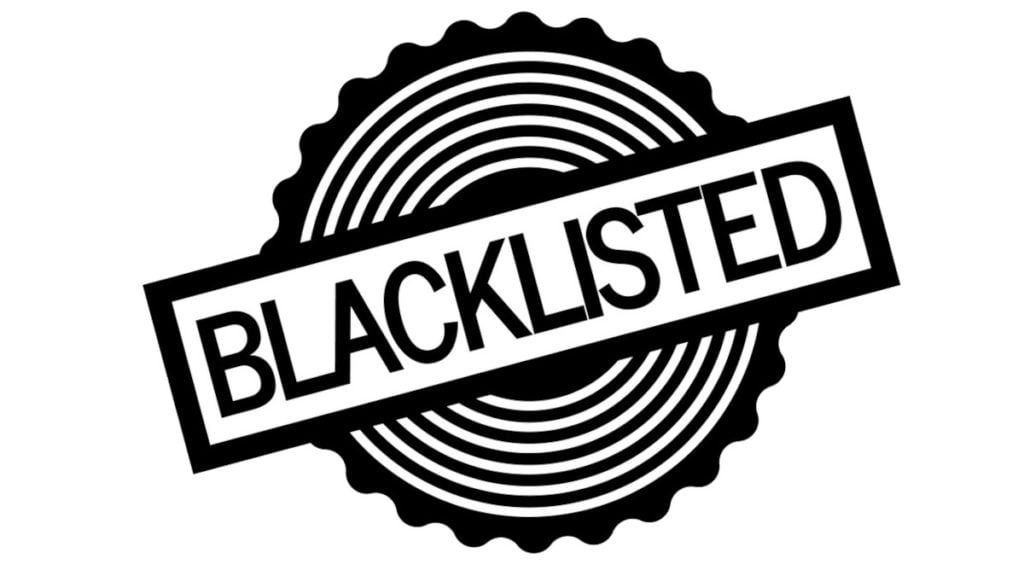If you use email marketing to reach your regular and potential customers, you must know that there is a possibility that your email address will be blacklisted. This is a common problem for those who use email to promote their business, but it is not unsolvable.
In this article, you will find out what it means to end up on an email blacklist, what practices to adopt so that it doesn’t happen, and how to handle the situation if it does.
What are email blacklists in email marketing?
Do you know what a blacklist is? In your everyday life, you may have heard this term in a variety of settings, although we hope you have not had direct experience with it.
People who end up on a blacklist are part of a list of people who, for example, are not allowed to attend certain events or who are not allowed to enter a certain venue. In email marketing something similar happens: the IP address linked to the email address from which you send your messages is placed on a blacklist (or blocklist) that is continually updated.
As a result, it becomes impossible for your emails to reach the recipients: your efforts to get conversions or sales are thwarted, and your reputation takes a hit. But fortunately, nothing (or almost nothing) is forever, not even blacklisting: find out in the next few lines how it works, how to avoid getting into it, and how to get out of it if you’ve already gotten into it.
How does a blacklist work?
Every day, it will certainly happen to you too, email users receive hundreds and hundreds of emails. They may be business emails, promotional emails, or DEM, as in the case of b2b or b2c email marketing, or messages the work of spammers, who send unauthorized communications, scam emails, and viruses.
To avoid the sending of unwanted messages someone created Blacklists.
They have constantly updated databases that include senders associated with spam, phishing, and similar content.
Blacklists work based on two criteria:
- Domain name: addresses that include a particular domain name are marked as spammers after users report them through their spam filters;
- Ip address: in this case, it is the IP address included in the list that is classified as a source of spam.
Who creates the blacklists?
Blacklists, also called blocklists, are created and used by ISPs or email service providers such as Gmail, Yahoo, or Outlook, to name a few. Some service providers use multiple blacklists at the same time, while others allow the user to create them (generally all allow you to classify junk mail).
Not only that, there are public blocklist providers that constantly monitor their database to defend against suspicious senders. Firewalls and antiviruses also provide an additional defensive filter that joins that of the mail server.
How does one get blacklisted?
Hopefully, you have never had to experience this, but you certainly know that you often find out that you have been blacklisted when you receive an error message. Technically, blacklisting can occur if a message is classified as spam or by the action of tools known as spamtrap. Let’s look at these options in detail.
Try ActiveCampaign to manage your email campaigns
Create professional emails, measure deliverability, and audit the sending of your campaigns with a free trial of the tools
Reported as spam
The recipient of an email can report the sender or message as spam to their email server to stop receiving communications from that address.
It may happen if the emails sent are perceived as harmful or annoying, if the user does not remember that he subscribed to the mailing list, or if his inbox is always full, thus making him ill-disposed toward new incoming messages.
Bounce
Bounce occurs when a sender or message is classified as spam and the email is returned to the sender. If this starts happening frequently, there will be negative consequences on email deliverability, i.e., the rate of messages sent, and thus on the results of your inbound email marketing campaigns.
Spamtrap
The terms “spamtrap” or “honeypot” refer to those mailboxes that on the surface are no different from regular mailboxes (indeed, sometimes they are disused mailboxes that are being reused), but which are set up specifically to detect email addresses that send junk mail.
Spamtraps are used by blacklisting vendors and primarily detect senders who send unwanted communications to users who have not provided consent. That is why ending up in them has a highly negative impact.
How to avoid getting blacklisted
So far we have talked about how you technically end up on a blacklist.
Let’s now see how to avoid being included in these lists and the spam folder: in the next few lines, you will discover what good practices to follow and what behaviors to avoid for this purpose instead.
Diversified content
If you have received spam emails, you will know that the content proposed is always the same, highly repetitive and of poor quality, as well as riddled with errors. To prevent your email address from being blacklisted, always propose valuable content to your users.
Use business address
To ensure that your address is not classified as spam, never send communications from your personal email: rather, a company should use corporate addresses to appear trustworthy in the eyes of users.
In many cases, you can use a dedicated third-level domain (i.e. newsletter.yourdomain.com) to maintain separate the email marketing system from the business mail system.
Using certified providers
Again, quality pays off. Always send your messages through secure mail servers from certified and reliable providers. Don’t skimp on this aspect.
Consent and purchase of mailing lists
To run successful email marketing campaigns, it is essential to obtain consent from all subscribers to your contact database, preferably through double opt-ins. For this reason, it is a good idea to avoid buying email addresses from users who have never subscribed to your mailing list.
In addition to negatively affecting your campaign metrics and appearing unreliable or unknown in the eyes of the reader, you often don’t really know how these addresses were obtained, with obvious implications for your Web reputation.
Do not collect contacts online
Even creating a mailing list by including email addresses found publicly on websites is not the same as obtaining the user’s prior consent. Therefore, it is neither legally correct nor does it help to achieve better email marketing metrics.
Verify your emails before sending
Verifying that the message to be sent has been written correctly and has no problems from a technical standpoint is a very important aspect of avoiding blacklisting.
In addition to making a test email to check content, image rendering, and links, many email management tools perform a spam check to ensure the deliverability of a message.
Remove old or stale email addresses
You should remove inactive contacts from your list who haven’t opened or clicked your emails in several months. This will help eliminate bounces and ensure high engagement.
You can clean your list before sending to ensure you’re not sending to stale or old email addresses.
Provide an unsubscribe link
You don’t need to worry about recipients unsubscribing from your one-off transactional emails. It will help your subscribers opt out of your emails so that they don’t receive a flood of unwanted emails.
Because unsubscribes are less serious than spam complaints, you should allow your recipients to unsubscribe.

Can I remove myself from the blacklist?
Being included on a blacklist is not something that necessarily lasts forever and it is possible to get off it. In general, you should check to see if you are in a blocklist and then request to be removed from it.
The process is sometimes a matter of a few hours: simply submit a request to a site set up as a reputation center, such as Barracuda.
How to manage the blacklist in your ESP
In addition to testing the campaigns you wish to send, using the email sending verification system, and regularly checking the delivery rate, a good ESP normally provides you with additional tools.
For example, ActiveCampaign and Mailchimp provide you with other tools to monitor deliverability, such as seed analysis, IP or domain reputation checking, content scanning, and blacklist checkup tools.

How to avoid blacklist in email marketing – Key Takeways
Email marketing is critical for your business. If your emails did not reach your leads and customers they cannot be effective.
These are some best practices:
- Choose a great email marketing service
- Obtain always consent from your subscribers and do not ever buy mailing lists or use public contacts
- Check your ESP tools for deliverability:
- use test tools before sendig a campaign mail
- frequentely clean your contact DB removing inactive and stale emails
- check the bounce rate
- If you are in a blacklist: stop sending mail, find the issue and ask for removal







